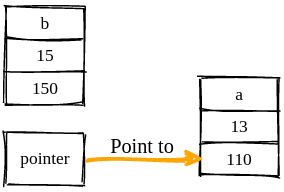Memory and Pointers

Definition
- An important notion in C++ is the notion of
pointer. - The implementation of Data structures rely heavily on pointers.
- They are an advanced tools as they allow the programmer to directly manipulate data in the memory.
The memory concept
The memory in your machine could be represented as row of chank (or block) each block has an address.
This has a huge similarity with array. Where indices are the addresses and the values has the bit encoding of values.

- In C++, the position of each block is given by a fixed address that give us its placement in the RAM.
In order to understand this concept, let’s imagines a variable:

Now in order to represent a variable, we store
- its names.
- its value.
- its Address.
For example the following diagram

represents a variable with the type string named name. Its value is
Erich and its address is 200.
An important point to remember, is that the Operating system who gives us this value.
Pointers and memory
Now lets imagine we want a variable that could change its memory placement. Or, we could imagine a variable (where its values are memory address).
//Simple variable
string var = "Erick"
// Variable to store the address of var
int *pointer = &var;

We could define a pointer as
A pointer is a variables whoses values are addresses.
Since the address of pointer in not important, we will use the following diagram:

Here is a simple program that uses pointers to manipulate the data:
#include <iostream>
using namespace std;
int main(int argc, char *argv[])
{
//Declare two variables
int a = 13;
int b = 15;
//Print there addresses.
cout<<"adresse of a: "<<&a<<endl;
cout<<"adresse of b: "<<&b<<endl;
//Create a pointer on int
int* p;
//p now point on a
p = &a;
cout<<"P pointe on : "<<p<<endl;
//Now we will change p
p = &b;
cout<<"Now P point on : "<<p<<endl;
return 0;
}


Take away
- Each variable has an address.
- Inversely, each address has unique memory value.
- The compiler knows the address of each variable. mémoire.
- If we have the address of a variable, we could extract its value.
Syntax
In order to declare a pointer, we precede the type with a star.
//A pointer on integers
int* p;
//Pointer on strings
string* p2;
//Pointers on vectors
vector<int> * pV;
Extraction
Once we declare a pointer, we could extract the value stored in the memory
which it point to using also the star operator.
this rise an ambiguity between the star of the declaration and the extracting operator.
//Declare a simple pointer
int a = 14;
int* p = &a;
//Print the adress and value
cout<<"[value: "<<a<<", adress: "<<&a<<"]"<<endl;
cout<<"[value: "<<*p<<", adress: "<<p<<"]"<<endl;
A good convention is to finalise a pointer that has no address to nullptr.
int *p = nullptr;
In this case, we must be careful as we canno’t use the extraction operator in an empty memory. Otherwise this will lead to the classical
segmentation faulterror.
Also we could test if the pointer is null by simply using the name of the pointer:
if(ptr) // pass the test if pointer is not null
if(!ptr) // pass the test if the pointer is null
arithmetic
We could use some useful arithmetic operations to manipulate pointers:
For two pointers \(p_1\) et \(p_2\):
p++: Goes to the next memory case.p + d: Jumps by \(d\) memory blocks.p--: return the previous block.p-d: Jump back to the \(d\) block.p1 < p2: boolean value that returns true if \(p_1\) precedes \(p_2\).
Pointers and arrays
array and pointers
A static array in C++ is simply a constant pointer to the first element. The constant aspect means that we cannot change is placement to avoid losing the memory stored by the array.
Hence if we declare a static array
//Declare a static array
int A[]{2,4,5,9,1};
- The first remark is that we cannot change the address of A. The expression
A++will leads to an error. - We could manipulate A either by indices or addresses.

Looping an array
Pour parcourir le tableau, on pourra utiliser l’une de ces trois méthodes:
We could use the pointers arithmetics to loop an array:
//Looping using indices
for(int i=0; i<5; i++)
cout<<A[i]<<" ";
//Same loop using the extracting operator
for(int i=0; i<5; i++)
cout<<*(A+i)<<" ";
//Advanced loop using pointers
for(int* p=A; p<A+5; p++)
cout<<*p<<" ";
Exercice:
Lets suppose that we have an STL vector, and we want to print its values using the pointers mechanism
You cannot use the [] operator nor the at function.
Hint: Search the data function.
void printVector(vector<int> Arr)
{
//You cannot use the [] nor at
}
Pointers and functions
For functions, we mentioned that we have the following type of passing arguments:
- by copy
- by reference.
- by
address.
Lets try to illustrate this concept for the classical exercise of swapping the values of two variables.
Here is a program that achieves this,
Focus on the last version which uses pointers.
#include <iostream>
using namespace std;
//First function no hope
void swap_copy(int a, int b)
{
auto tmp = a;
a = b;
b = tmp;
}
//Second version (Prefered) references
void swap_ref(int &a, int &b)
{
auto tmp = a;
a = b;
b = tmp;
}
//Third version (advanced) adresse
void swap_add(int *a, int *b)
{
auto tmp = *a;
*a = *b;
*b = tmp;
}
int main()
{
int a = 45;
int b = 30;
//Calling the first one
swap_copy(a, b);
cout<<"State after swap copy: \n";
cout<<"[a: "<<a<<", b:"<<b<<"]\n";
//Calling the second one
swap_ref(a, b);
cout<<"State after swap_ref: \n";
cout<<"[a: "<<a<<", b:"<<b<<"]\n";
a = 45;
b = 30;
//Call by adress (pay attention to the adresses)
swap_add(&a, &b);
cout<<"State after swap_add: \n";
cout<<"[a: "<<a<<", b:"<<b<<"]\n";
return 0;
}
Memory allocation
Now we will turn our attention to the advantages of using pointers to create dynamic array which could change their capacity.
Memory allocation refers to the concept for creating memory in the
heapin the fly (at run time).
In order to manage the memory space created in the heap, we must use pointers!!
Allocation
In order to create memory space, we use the new operator. For example:
//pointer
int *ptr;
//Allocate a single case
ptr = new int;
//Give a value to this value
*ptr = 45;
In this example, we created a single value and we used the pointer p to manipulate its data.
A question arises, is how can we allocate several valuees like an array.
//pointer as an array
int *Arr;
//allocate n cases
Arr = new int[3];
// allocate another spaces
//(memory leak as we forget to delete the previous space)
Arr = new int[6];
In a general way to allocate N blocks of type T is
T* ptr = new T[N];
Destruction
As mentioned in the previous example, as C++ programmer you must manage your memory use, Hence you must delete any space that is in use anymore.
As as rule of thumb, if you allocate a memory space, it is your responsibility to delete it.
Memory space could be deleted by the delete operator.
delete ptr: delete a single value.delete [] ptr: delete a space by a vector.
//Pointer
int *ptr;
//allocate a single value
ptr = new int;
//Delete this value
delete ptr;
//allocate 5 values
ptr = new int[5];
//Delete this space.
delete [] ptr;
